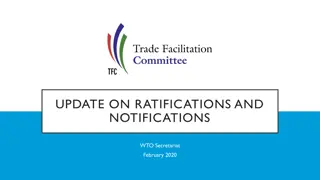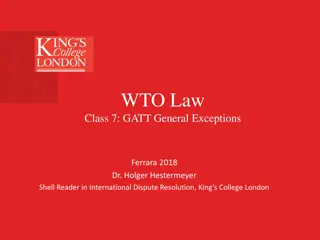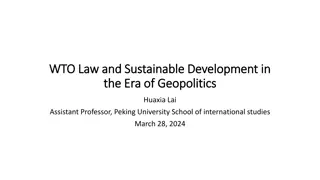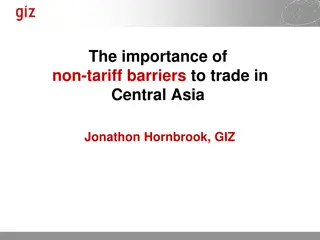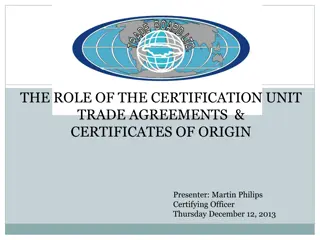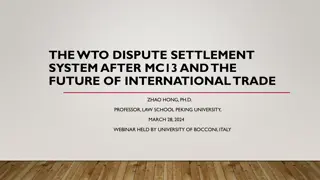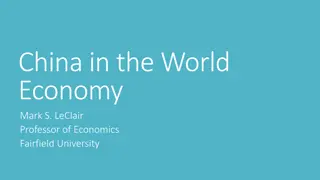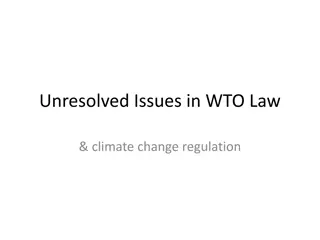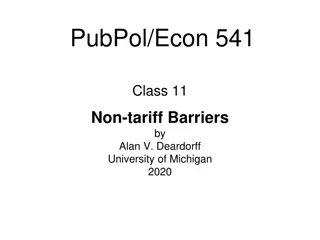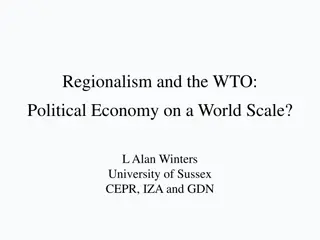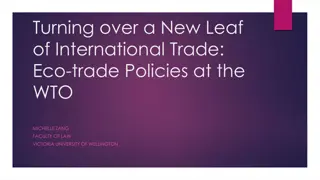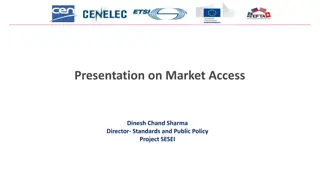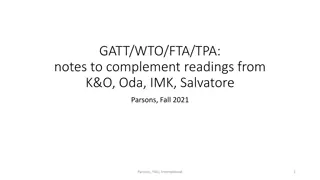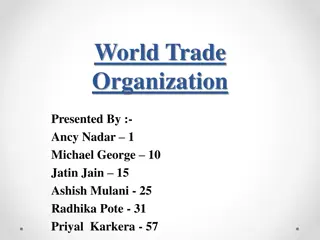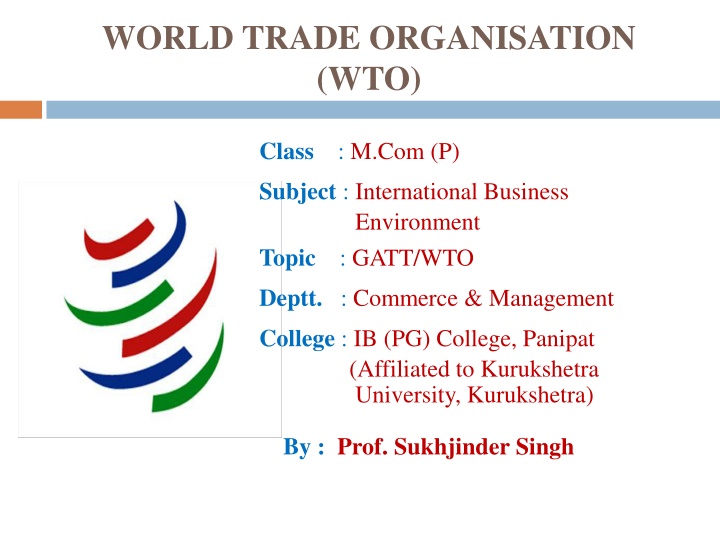
GATT and WTO in International Trade
World Trade Organisation (WTO) and General Agreement on Tariffs and Trade (GATT) are key players in regulating global trade, with GATT establishing trade rules post-WW2 and later evolving into WTO in 1995. Explore the origins, formation, principles, objectives, and GATT Rounds to grasp the significance of these trade bodies in shaping international commerce. Learn about the mission to provide equal opportunities, resolve trade disputes, and enhance living standards worldwide.
Download Presentation

Please find below an Image/Link to download the presentation.
The content on the website is provided AS IS for your information and personal use only. It may not be sold, licensed, or shared on other websites without obtaining consent from the author. If you encounter any issues during the download, it is possible that the publisher has removed the file from their server.
You are allowed to download the files provided on this website for personal or commercial use, subject to the condition that they are used lawfully. All files are the property of their respective owners.
The content on the website is provided AS IS for your information and personal use only. It may not be sold, licensed, or shared on other websites without obtaining consent from the author.
E N D
Presentation Transcript
WORLD TRADE ORGANISATION (WTO) Class : M.Com (P) Subject : International Business Environment Topic : GATT/WTO Deptt. : Commerce & Management College : IB (PG) College, Panipat (Affiliated to Kurukshetra University, Kurukshetra) By : Prof. Sukhjinder Singh
What is WTO? World Trade Organisation (WTO) is a regulatory body that deals with the rules of trade between nations at a global or near-global level. It s a forum for governments to negotiate trade agreements. It s a place for them to settle trade disputes. It operates a system of trade rules. The WTO replaced GATT in 1995.
Origins of GATT The prolonged recession before the world war 2nd& the devastation caused by the world war 2nd led to the BRETTON WOODS Conference. In International Conference on Trade and Employment in Havana in the winter of 1947-48, fifty-three nations drew up and signed a charter for establishing an International Trade Organisation (ITO). The US Congress did not ratify the Havana Charter with the result that the ITO never came into existence.
How GATT Was Formed ? Twenty-three nations agreed to continue extensive tariff negotiations for trade concessions at Geneva, which were incorporated in a General Agreement of Tariffs and Trade. This was signed on 30th October 1947 and came into force form 1st January 1948 when other nations had also signed it. The General Agreement on Tariffs and Trade (GATT) is neither an organisation nor a court of justice. It is simply a multinational treaty which now covers eighty per cent of the world trade.
Principles of GATT Trade without Discrimination/ Non discrimination Protection only through tariff or Prohibition of quantitative restrictions Stable basis of trade Consultation- open discussions for conflict resolution Foreign entities treated same as domestic entities
Objectives of GATT To provide equal opportunities to all countries in international market for trading. To increase the effective demand for real income growth and goods. To minimize tariffs on trade for ensuring mutual benefit. To provide proper solution to the disputes related to international trade. To ensure a better living standards in the world as a whole.
Uruguay Round Package The Eighth Round of GATT was known as Uruguay Round, 1986-93, and 123 countries participated in this Round. The final act was signed by 12 countries in which India was signatory. Popularly known as Dunkel agreement, It finally emerged as the World Trade Organisation (WTO) on 1st January, 1995. Child becomes a Parent & Parent a child
Criticism of GATT Problems in formulation of General rules Slow dispute settlement mechanism Less benefits for the LDC s No enforcement authority Quantitative Trade Restrictions Formation of regional groups
Establishment of WTO The WTO is the embodiment of the Uruguay Round results and the successor to the General Agreement on Tariffs and Trade (GATT). GATT is replaced by WTO. The World Trade Organisation (WTO) was established on 1st January 1995. India is one of the founder members of the WTO. The World Trade Organization (WTO) is an intergovernmental organization that regulates international trade.
Fact File of the WTO Formation 1 January 1995 Type International trade organization Headquarters Geneva, Switzerland Membership 164 member states Official language English, French, Spanish Purpose Reduction of tariffs and other barriers to trade
Objectives of WTO To set and enforce rules for international trade To provide a forum for negotiating and monitoring further trade liberalization To resolve trade disputes To increase the transparency of decision-making processes cooperate with other institutions involved in global economic management. To major international economic To help developing countries benefit fully from the global trading system
Functions of WTO It facilitates the implementation, administration and operation of the objectives of the Agreement and of the Multilateral Trade Agreements. It provides the framework for the implementation, administration and operation of the bilateral Trade Agreements relating to government procurement, trade in diary products and bovine meat. It administers the Understanding Procedures governing the Settlement of Disputes of the Agreement. trade in civil aircraft, on Rules and
ContdFunctions It shall be responsible for the settlement of differences and disputes countries. It cooperates with the IMF and the World Bank and its affiliated agencies with a view to achieving greater coherence in global economic policy- making. It shall be responsible for carrying out periodic reviews of the trade policies of its member countries. among its member
WTO Agreement GATS - General Agreement on Trade in Services TRIPs - Trade Related Intellectual Property Rights AOA Agreement on Agriculture TRIMs - Trade Related Investment Measures Dispute Settlement Anti Dumping
GATS It is a General Agreement on Trade in Services. It covers 4 modes of international delivery of services: border flow (Trans transportation services) Cross border data flows, Commercial presence (Provision of services abroad thru FDI , etc..) Consumption abroad Movement of personnel (Entry & temporary stay of foreign consultants)
TRIPs Trade Related Aspects of Intellectual Property Rights IPR are the rights given to persons over the creation of their minds. 1. Copy rights & related rights 2. Trademarks 3. Geographical indications 4. Industrial design 5. Patents
AOA Agreement on Agriculture There are 3 principal commitments.. Market Access :- no import restrictions & limitations Domestic support :- Elimination of govt. support to domestic company s. Export subsidies :- phase out support given to exporters .. Other important aspects are:- a) Tariffication :- means removal of tariff quotas. b) Tariff binding :- means fixing the max rate of import duty, above which a country does not raise the duty unilaterally.
TRIMs It is Trade Related Investment Measures No country shall apply TRIMS which is inconsistent with WTO articles . The following are inconsistent :- Local content requirement Trade balancing requirement Trade & foreign exchange Domestic sales requirement.
Dispute Settlement Dispute settlement or dispute settlement system (DSS) is regarded by the World Trade Organization (WTO) as the central pillar of the multilateral trading system, and as the organization's "unique contribution to the stability of the global economy". It has a fixed dead line in settlement of disputes . The first ruling does not extend beyond 1 year. The appeal is generally disposed off before 60 days.
Anti-Dumping Measures Meaning- It means selling the product at below the on going market price or at the price below the cost of production. Anti-Dumping laws is applicable if the margin of dumping is more than 2% of the export price or the volume of dumped products is more than 3% of the product. Anti-Dumping duty shall not exceed the margin of dumping . Anti-Dumping action may be suspended or terminated if the exporter agrees to remove the dumping or the injurious effect of it.
Distinction between GATT and WTO GATT WTO The WTO has a legal status. The GATT had no status. The WTO dispute settlement mechanism is binding on all parties. The GATT dispute settlement system was dilatory and not binding on the parties. faster and The WTO covers both trade in goods and trade in services. The GATT rules applied to trade in goods. WTO is an organization. GATT WAS an agreement.
India and WTO India is a founding member of the GATT (1947) as well as of the WTO, which came into effect from January 1, 1995. By virtue of its WTO membership, India automatically avails of Most Favoured Nation Treatment (MFN) and National Treatment (NT) from all WTO members for its exports and vice versa. India has fulfilled its commitment by reducing tariff and eliminating QR. The Indian economy has grown rapidly over the past decade, with real GDP growth.
Criticism of WTO The WTO serves the interest of multinational corporations and wealthy nations. Barriers are lowered by developing countries whilst developed world still maintains barriers in agriculture. The WTO is increasing inequality. Fundamental principles and aims of the WTO are not beneficial for all parties involved. The WTO undermines local development and penalizes poor countries. Free trade means local cultures are replaced with Coca Cola, Starbucks and McDonalds.
Conclusion It is the place where the member country comes and talks together and shares their grievance in order to resolve their problem related to International trade. The countries make their decisions through various councils and committees, whose membership consists of all WTO members. The system helps promote peace, by handling Dispute of member countries. It provides free trade which cuts the costs of living and provides more choice of products and qualities and stimulates economic growth.
Thank You! WTO International designed to play the role of a watchdog in spheres of Goods, services foreign investments, IPR etc. is an body trade in

